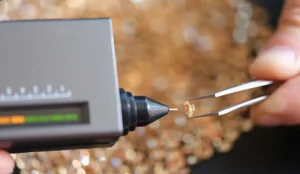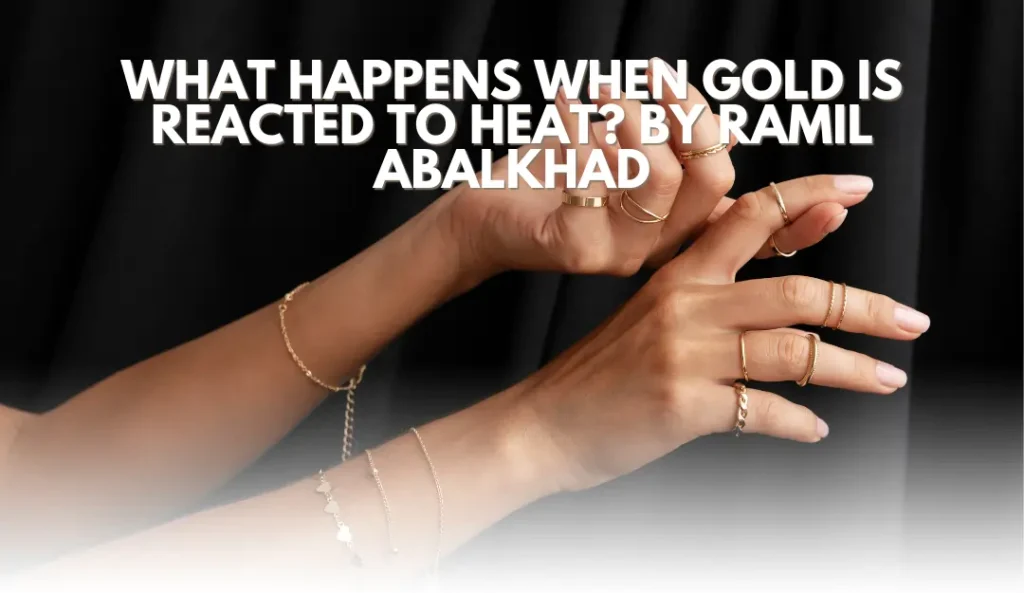Gold, the symbol of wealth and beauty, is more than just a precious metal. Its unique properties make it an object of fascination for both scientists and jewelers. When subjected to heat, gold behaves in intriguing ways, showcasing physical and electrical changes while maintaining its chemical stability. Let’s delve into the details of what happens when gold is exposed to heat and why this noble metal continues to hold such unparalleled significance in modern and historical contexts.
Does Gold React to Heat?
Pure gold is chemically inert, meaning it does not react with oxygen or other gases even when exposed to high temperatures. Unlike metals that tarnish or corrode, gold remains visually unaltered, retaining its signature luster and color. This resistance to oxidation and corrosion makes it a preferred material in industries requiring durability and reliability.
Physical Changes in Gold When Heated

- Thermal Expansion:
Gold expands when heated and contracts when cooled, a property measured by its coefficient of thermal expansion, 13.4 x 10⁻⁶ per degree Celsius (1/°C).- A 1000 mm gold bar heated from 25°C to 125°C will expand to 1001.34 mm.
- Conversely, cooling the same bar to -75°C would shrink it to 998.66 mm.
- These small changes in dimension are critical in applications like electronics and precision engineering, where even minute shifts can impact functionality.
- Melting and Boiling Points:
- Melting Point: Gold melts at 1,063°C (1,945°F), transitioning from solid to liquid.
- Boiling Point: At 2,966°C (5,371°F), gold turns into vapor.
- These high thresholds underscore gold’s stability under extreme conditions, making it invaluable in industrial and scientific applications.
Electrical Changes in Gold When Heated
Gold is an excellent conductor of electricity, and its resistance to electrical flow varies predictably with temperature.
- Temperature Coefficient of Resistivity: 0.0034 per degree Celsius (1/°C).
- Heating a gold wire with a resistance of 10 Ω from 25°C to 125°C increases its resistance to 10.34 Ω.
- Cooling the same wire to -75°C decreases its resistance to 9.66 Ω.
This predictable behavior ensures gold’s reliability in high-performance electronic components such as connectors, terminals, and printed circuits.
Applications of Gold’s Heat Stability
- Electronics and Technology:
Gold’s ability to withstand heat without reacting chemically or losing conductivity makes it a staple in advanced technology. Thin films of gold are used in satellite components, reflecting up to 98% of infrared radiation to regulate temperature. - Jewelry and Artifacts:
Gold’s resistance to tarnishing ensures that it retains its beauty over centuries. Its malleability also allows artisans to create intricate designs without the risk of cracking or breaking. - Industrial Uses:
- Gold-coated visors protect astronauts from harmful solar radiation.
- Gold films on office windows reduce heat absorption, lowering energy consumption for cooling.
Q :Does gold get hot in the sun?
Yes, gold absorbs heat from sunlight, and like any other material, it can become hot when exposed to direct sunlight. However, gold has a high thermal conductivity, which allows it to distribute heat evenly and cool down quickly when removed from the source.
Q:What happens when copper is heated?
When copper is heated, it oxidizes and forms a black or greenish layer of copper oxide on its surface. This reaction occurs because copper readily reacts with oxygen in the air when exposed to high temperatures.
Q:Why is my gold turning black when I melt it?
Pure gold does not turn black when melted. However, if your gold appears black, it might be due to impurities or alloying metals like copper or silver, which can oxidize and discolor during the melting process.
Q: Is gold durable?
Yes, gold is incredibly durable. It resists tarnishing, corrosion, and rust, making it an ideal material for crafting long-lasting jewelry and other items. Pure gold is soft but can be alloyed with other metals to increase its strength without losing its aesthetic appeal.
Q: Does 18k gold turn black when you burn it?
18k gold, which contains 75% pure gold, typically does not turn black when burned. However, the alloying metals used in 18k gold may oxidize under extreme heat, causing discoloration. This is why it’s essential to use proper techniques when working with gold.
Q:What temperature does gold burn?
Gold does not burn in the traditional sense. Instead, it melts at 1,063°C (1,945°F) and boils at 2,966°C (5,371°F). Since gold is a noble metal, it doesn’t combust or degrade even at extremely high temperatures.
Q:Is gold magnetic?
No, gold is not magnetic. If your gold jewelry or item is attracted to a magnet, it likely contains other metals or impurities. Pure gold remains non-magnetic even under strong magnetic fields.
Q:Gold melting point
Gold melts at a temperature of 1,063°C (1,945°F). This precise melting point is a property that Ramil Abalkhad, as a jeweler, carefully considers when working with gold to craft fine jewelry.
Gold and Modern Science: 2025 Updates
The exploration of gold’s thermal properties has advanced significantly. Innovations in nanotechnology now leverage gold nanoparticles to harness heat for medical treatments like cancer therapy, where nanogold converts light into heat to target tumors. Additionally, gold’s role in sustainable technologies, such as efficient solar cells and hydrogen production, is expanding, ensuring its relevance in green energy solutions.
Conclusion
When gold encounters heat, its physical and electrical properties may change slightly, but its chemical structure remains untouched. This resilience, combined with its beauty and versatility, makes gold one of the most remarkable materials known to humanity. Whether in ancient artifacts or cutting-edge technologies of 2025, gold continues to shine brightly, proving its worth as both a treasure and a tool.
By understanding what happens when gold is exposed to heat, we not only appreciate its inherent value but also its crucial role in advancing science, technology, and art. Read: How to Clean Gold Jewelry.

